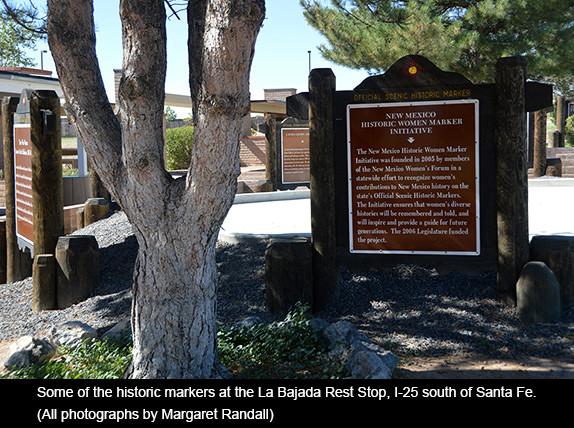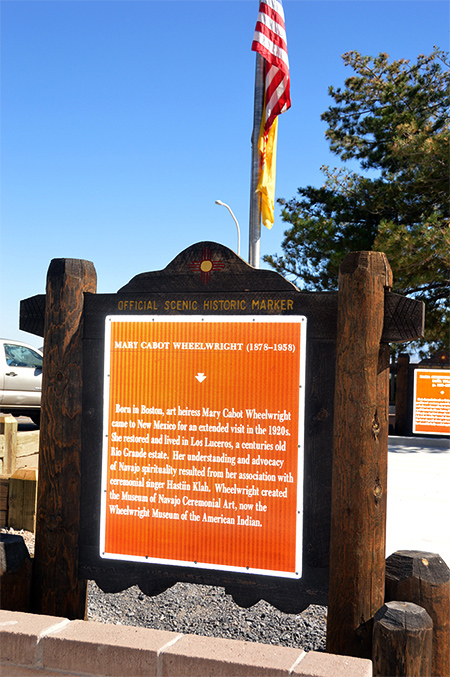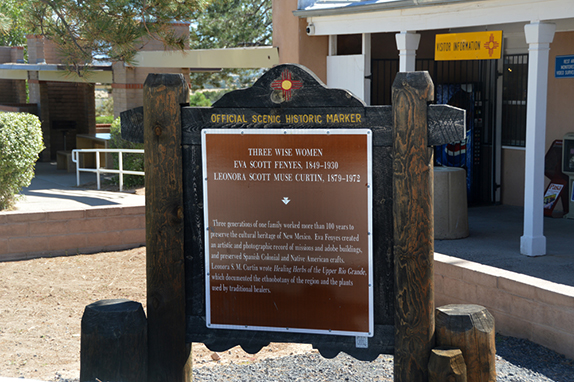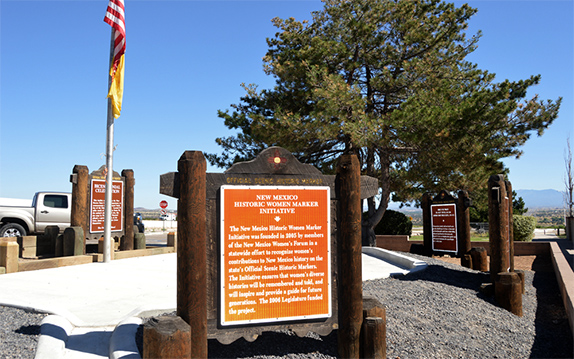
Driving north from Albuquerque, just a few miles before the Santa Fe exits, La Bajada Hill has been a natural landmark, written about for its geography, history, and ancient rock art. The feature was written about long before Interstate #25 became the efficient link between Albuquerque and Santa Fe.
Just past La Bajada, there is a very special rest stop on the east side of the highway. Such stops typically offer restrooms, maybe a picnic table or two, and perhaps an assortment of tourist information and maps. You hope for cleanliness, possibly a cup of coffee to energize your drive. Anything additional is a plus.
At La Bajada Rest Stop, you are surprised by all of this and more. The architecture is simple and appealing. Several well-built shelters house picnic tables and benches. Immediately, you notice an unusual group of historic markers, those informative brown signs that in New Mexico are almost always framed by rough wooden stands. If you take the trouble to read these markers, you will see that they all refer to women who contributed to our state’s history and culture—as scientists, artists and patrons of the arts, politicians, and early caretakers of the poor and vulnerable.

Mary Cabot Wheelwright, came from the East in the early twentieth century, developed a meaningful friendship with Navajo medicine man Hastiin Klah, and created the Museum of Navajo Ceremonial Art, today the Wheelwright Museum of the American Indian. At the museum, a brief but informative film tells her story. Like Mabel Dodge Lujan and other easterners, Wheelwright revealed aspects of our region’s value to those who were born here.
Eva Scott Fenyes (1849-1930) and Leonora Scott Muse Curtin (1879-1972) were members of a single family that worked for more than a century to preserve the cultural heritage of New Mexico. Eva Fenyes created an artistic and photographic record of missions and adobe buildings and preserved Spanish Colonial and Native American crafts. Leonora Curtin wrote Healing Herbs of the Upper Río Grande, documenting the ethnobotany of the region and the plants used by traditional healers. She also worked to preserve our varied cultures.


As the nineteenth century ceded to the twentieth, Laura Gilpin (1891-1979) was one of the country’s preeminent photographers. Among her iconic images are many of Navajo and Pueblo peoples, and evocative (but never romanticized) Southwestern landscape.
Much has been written about the priests who entered the New Mexico territory with the Conquest and have been credited with activities ranging from culturally important to abusive. Traditional histories say almost nothing about the hard-working religious sisters who often bore the brunt of sacrifice and were far less arrogant. Poet Renny Golden, in her beautiful collection Blood Desert: Witnesses 1820-1880 (University of New Mexico Press, 2010) writes about some of these women:
What Catherine remembers has voice as if ink could
sob or laugh the way ecstatic youth love wild
chance, the blessing of those years of Nuevo México (…)
It took a woman poet to give us the silenced part of history. Look for Golden’s book. It is a worthwhile read from beginning to end. At La Bajada Rest Stop there is a marker commemorating those Sisters of Charity.

The New Mexico Historic Women Marker Initiative was founded in 2005 by members of the New Mexico Women’s Forum in a statewide effort to recognize women’s contributions to New Mexico history on the state’s Official Scenic Historic Markers. As one of the markers at Bajada Hill tells us, “The initiative ensures that women’s diverse histories will be remembered and told, and will inspire and provide a guide for future generations.” The project was funded by the 2006 state legislature.
New Mexico is full of surprises. Finding women’s histories beautifully recorded at a highway rest stop is one.

December 11, 2014